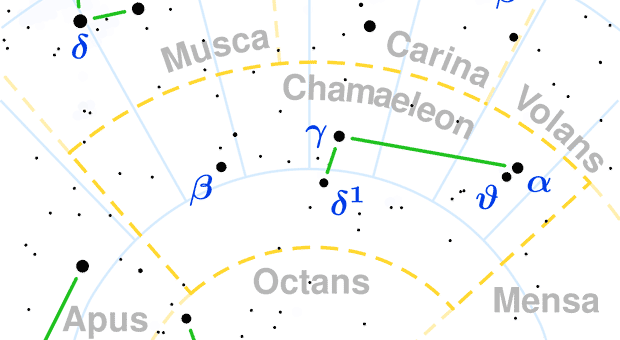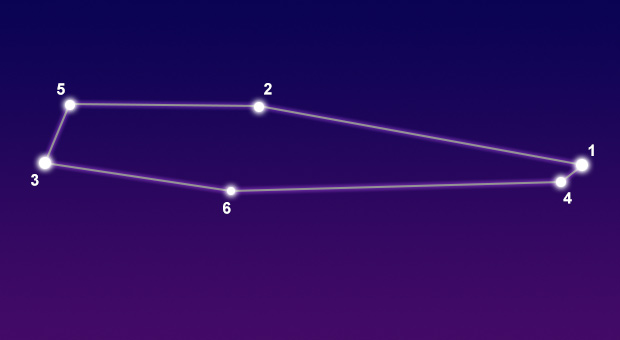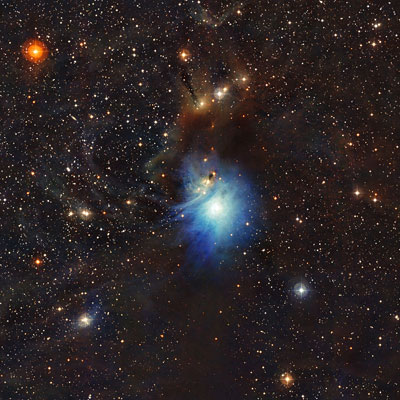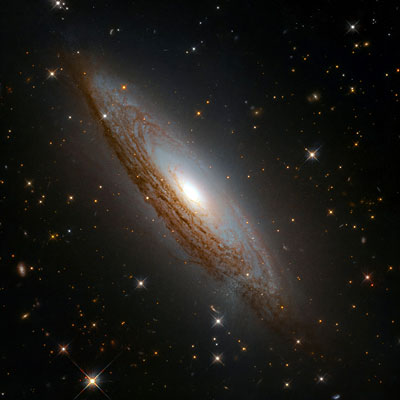Pronunciation:
(kuh-MEE-lee-un)Abbreviation:
ChaGenitive:
ChamaeleonotisRight Ascension:
11 hoursDeclination:
-80 degreesArea in Square Degrees:
132Crosses Meridian:
9 PM, April 15Visible Between Latitudes:
0 and -90 degreesThe constellation Chamaeleon, the chameleon, is located in the southern hemisphere of the sky. It is only visible in southern latitudes south of 0 degrees. It is a circumpolar constellation, meaning that it is visible all night as it rotates around the south celestial pole. With a total area of only 132 square degrees, it is one of the smallest constellations in the night sky. It ranks 79th in size among the 88 constellations. It is bordered by the constellations Apus, Carina, Mensa, Musca, Octans, and Volans. Only those with vivid imaginations can make a lizard out of the dim stars in this constellation.
There is no mythology associated with the Chameleon. The constellation is located so far south that it was not visible to the ancient Greeks or Romans. It represents a chameleon, a type of lizard with the ability to change colors. It is one of twelve constellations created by the Dutch astronomer Petrus Plancius based on observations made by Dutch navigators. It first appeared on a celestial globe published by Plancius in 1597. It was later included Johann Bayer’s star atlas in 1603. It was depicted as a chameleon sticking its tongue out to catch the fly represented by the neighboring constellation Musca.


Gamma Chamaeleontis
Beta Chamaeleontis
Theta Chamaeleontis
Epsilon Chamaeleontis
Delta-1 Chamaeleontis
N/A
N/A
N/A
N/A
N/A
Red Giant Star
Blue-White Star
Binary Star System
Binary Star System
Orange Giant Star
4.11
4.25
4.35
4.88
5.47
Chamaeleon is a dim constellation with no stars brighter than magnitude 4. The brightest star in the constellation is Alpha Chamaeleontis with a visual magnitude of 4.06. It is a blue-white giant star located about 64 light years from Earth. The second brightest star is Gamma Chamaeleontis with a magnitude of 4.11. It is a red giant star located approximately 413 light years away. Beta Chamaeleontis is the third brightest star with a magnitude of only 4.25. It is a blue-white star that lies some 270 light years from our solar system.
Chamaeleon contains no Messier objects but there are a few notable deep-sky objects. The Chamaeleon Cloud Complex is an area that contains a number of molecular clouds. It is a star-forming region that is currently forming low-mass T Tauri type stars. ESO 021-G004 is a spiral galaxy with dark dust lanes running through its spiral arms. NGC 3195 is a planetary nebula formed when an old star shed its outer layers of gas into space. The Eta Chamaeleontis Cluster is an open star cluster that contains about 12 young stars. These objects are extremely dim and can only be seen with a large telescope.

© European Southern Observatory / CC BY 4.0

© ESA/Hubble / CC BY 4.0



